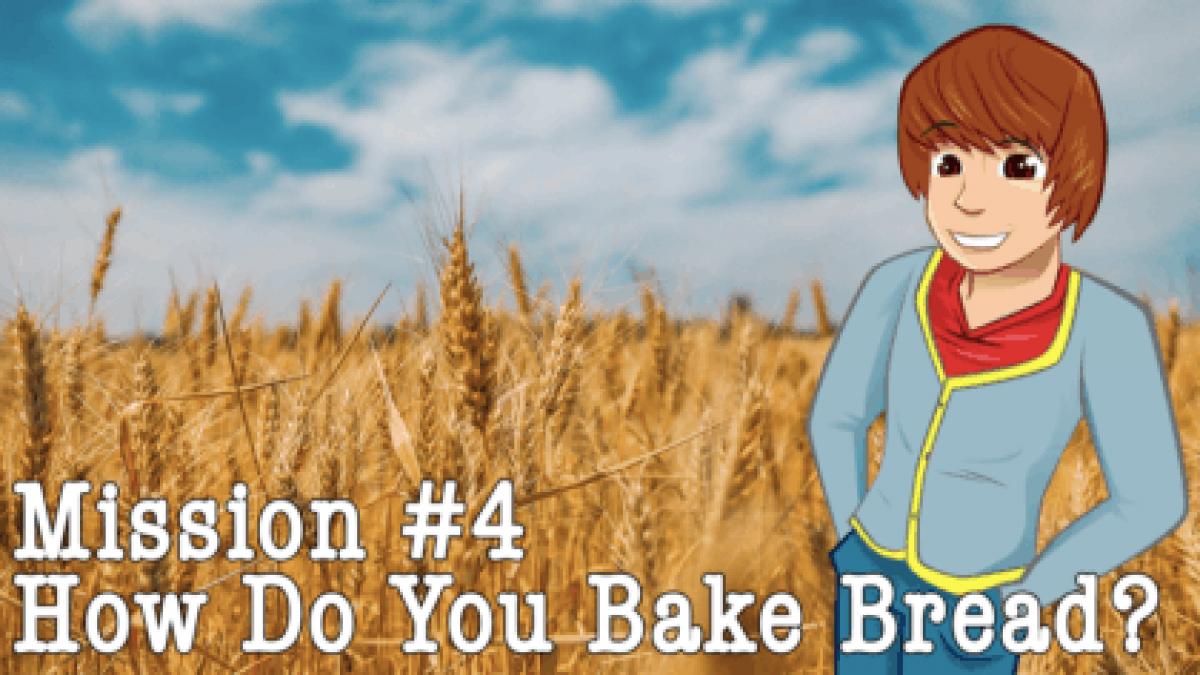Meet George
George is a curious student who loves food!
Anything to do with food he wants to know about, so he’s here to help us find out everything we can about baking!

Watch this video…
After that you should have a good idea of what goes in to baking a loaf of bread.
So how do you bake bread?
Despite there being loads and loads of different types of bread – like baguettes, sourdough, brown bread and ciabatta – they all have the same basic recipe.
Some might have slightly different ingredients and steps to the recipe, but they broadly follow the process we’re going to be looking at.

First you need to get all your ingredients together:
Flour
This is one of the main ingredients and comes from wheat that has been milled.

Salt
This helps with the breads taste and with the proving stage of bread making (this is where you let the dough rest).

Water
This is needed to form the gluten in bread – this is what gives the dough and bread it’s texture.

Vinegar
This is important as it makes the water more acidic which makes the yeast work better.
It also slows down the process of the bread going mouldy.
Vegetable Fat
This helps the bread to keep the gasses that are released during the baking and improves the texture of the bread.
Yeast
Yeast is very important as it makes the bread rise and makes all the bubbles in the bread. Think about the bread you eat at home – it’s not a solid slab of bread, it’s a bit light and airy which makes it delicious! That’s thanks to the yeast.
Yeast makes the bubbles by feeding off the sugars in the flour and expelling carbon dioxide.
The stages of making bread
1. Mix your ingredients
You need to mix all your ingredients together very quickly. They all need to be mixed within about 5 minutes to get the best bread.
This will make a sticky ball of dough.

2. Kneading
The dough is then kneaded, this is when you push and batter the dough. This makes the texture of the dough better.
In big bakeries they will have a machine do this for them.

3. Proving
Next the dough is proved – which just means leaving it so that the yeast can do it’s thing and create lots of little bubbles in the dough.
4. Knead it again
After proving the bread will have lots of big bubbles in it so you need to knead it again to push out all the bubbles that are too big, otherwise the final bread will have giant holes in it!
5. Prove again
Next you leave it for even longer just to let all the ingredients do what they need to and let the yeast make more bubbles.
6. Bake!
Here comes the actual baking part.
Put your dough in the oven to bake it. This kills off the yeast cells (so they stop making bubbles) and turns the dough into bread!
Did you know?
In the UK we buy 12 million loafs of bread every day! That’s a lot of bread that needs baking.
Your mission is to make bread
Before you start make sure you have an adult who can help you.
Once you have an adult to help all you need to do is find a recipe for bread that you want to make, below is one for white bread you can follow.
Ingredients:
- 500g strong white bread flour
- 1 ½ tsp salt
- 1 tsp caster sugar
- 7g fast action yeast
- Oil a 1kg loaf tin, then in a mixing bowl mix together the flour, salt and sugar. Then add the yeast and mix again. Next, slowly stir in 300ml of warm water until you have a slightly sticky dough.
- Flour your surface and knead the dough for about 15 minutes until the dough is nice and elastic. Then form it into a smooth ball and place in a lightly oiled bowl. Cover the dough with a tea towel or cling film and leave to prove in a warm place for 2 hours. The dough should double in size.
- Tip the risen dough onto a floured surface and knead for 2 minutes to get the dough nice and smooth. Next smooth the dough out making it tight and smooth on top and place it in the loaf tin. Cover with oiled cling film and prove for 1 hour.
- Pre heat your oven to 220 degrees (200 if using a fan oven). Then turn the dough over, cover with oiled cling film and prove for another hour.
- Sprinkle some flour on top of the dough, get your adult helper to make a score along the length of the dough and place it in the oven for 35 minutes.
- Now all you have to do is get your bread out of the tin and let it cool down!
Check back tomorrow for another mission all about baking
Add a commentWeek 7: Baking
This week's missions are all about baking! How do we make bread? What is grain? And what does yeast do? We're finding out!
More From Week 7: Baking






